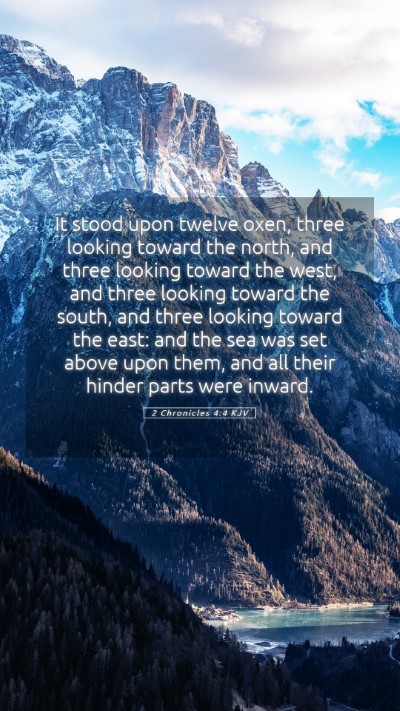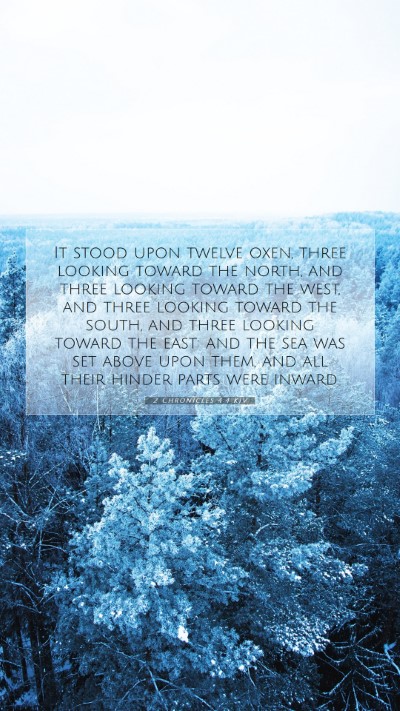2 Chronicles 4:4 - Bible Verse Meaning and Commentary
The verse 2 Chronicles 4:4 states: "And the sea was set upon twelve oxen, three looking toward the north, and three looking toward the west, and three looking toward the south, and three looking toward the east: and the sea was set above upon them, and all their hinder parts were inward."
Overview and Context
In this passage, we find a description of the great molten sea made by King Solomon for the Temple. This verse is situated within the broader context of the furnishings of Solomon's Temple, emphasizing the importance of the temple as a place of worship and ceremonial purification.
The molten sea was a large basin used for the priests to wash and purify themselves before performing their sacred duties. Understanding this setup is key to appreciating its symbolic significance in both the Old Testament ceremonial law and its implications in New Testament theology.
Insights from Public Domain Commentaries
-
Matthew Henry highlights that the structure of the molten sea, resting on the twelve oxen, symbolizes strength and stability. The number twelve can represent completeness in God’s people, reflecting the unity of the tribes of Israel.
-
Albert Barnes notes the distinct positioning of the oxen, indicating a divine oversight of the four cardinal directions, suggesting that God’s presence and oversight extend to all parts of the earth. This is a powerful reminder of God’s omnipresence and sovereignty.
-
Adam Clarke elaborates on the practicality of the molten sea, explaining that the design allowed for ample space for the cleansing rituals, which were essential for the purity required in the service of God. The inward design also indicates a deep spiritual meaning—focusing on inward purification.
Theological Significance
The description of the sea and its base serves as a rich metaphor for spiritual nourishment and cleansing. Water in biblical terms often symbolizes life and purity, and here it points to the necessity for spiritual renewal in the lives of believers.
The twelve oxen represent the strength of God's covenant with His people, emphasizing His providential care. This connection to the tribes of Israel also invites reflection on the New Testament understanding that believers, regardless of their background, are joined through Christ.
Furthermore, the design of the molten sea serves as a precursor to the teachings of Jesus regarding inward purity and the necessity of being cleansed from sin—a theme that resonates through the New Testament.
Applications for Bible Study
When studying 2 Chronicles 4:4, individuals and bible study groups can utilize this verse to explore themes of sanctity and preparation for divine service. It can generate discussions about:
-
Spiritual cleansing—How does the concept of purity apply to our lives today?
-
The role of tradition—What historical significance does the temple and its furnishings hold in contemporary worship?
-
God’s omnipresence—How does the geographic symbolism of the oxen translate to our understanding of God’s nature?
Cross References
To deepen your study and understanding of 2 Chronicles 4:4, consider the following related passages:
- 1 Kings 7:23-26 - Provides a parallel account of the molten sea's description and its significance within the Temple.
- Psalms 104:25 - Reflects on the majesty of God's creation, which complements the themes of strength and stability.
- Hebrews 10:22 - Discusses approaching God with a true heart in full assurance of faith, aligning with the need for purification symbolized by the molten sea.
Conclusion
In summary, 2 Chronicles 4:4 offers rich insights into the significance of the Temple's design and worship practices among the Israelites. The study of this verse aids in understanding Scripture through a lens of historical context, spiritual symbolism, and practical applications for believers today. For those seeking bible verse meanings and bible verse interpretations, this passage serves as a foundational example of the deep layers found within Scripture.


